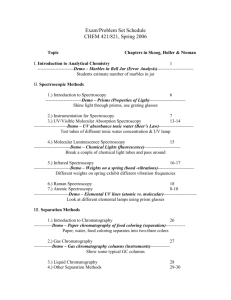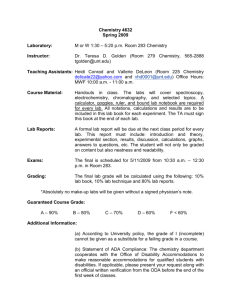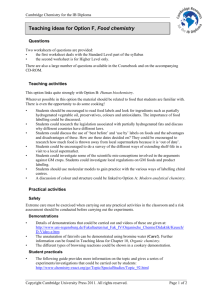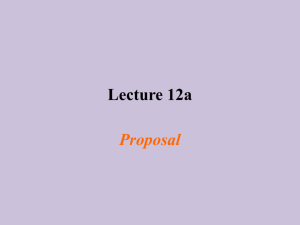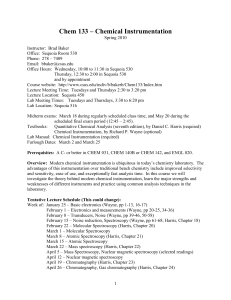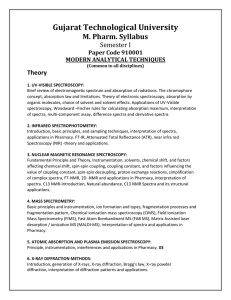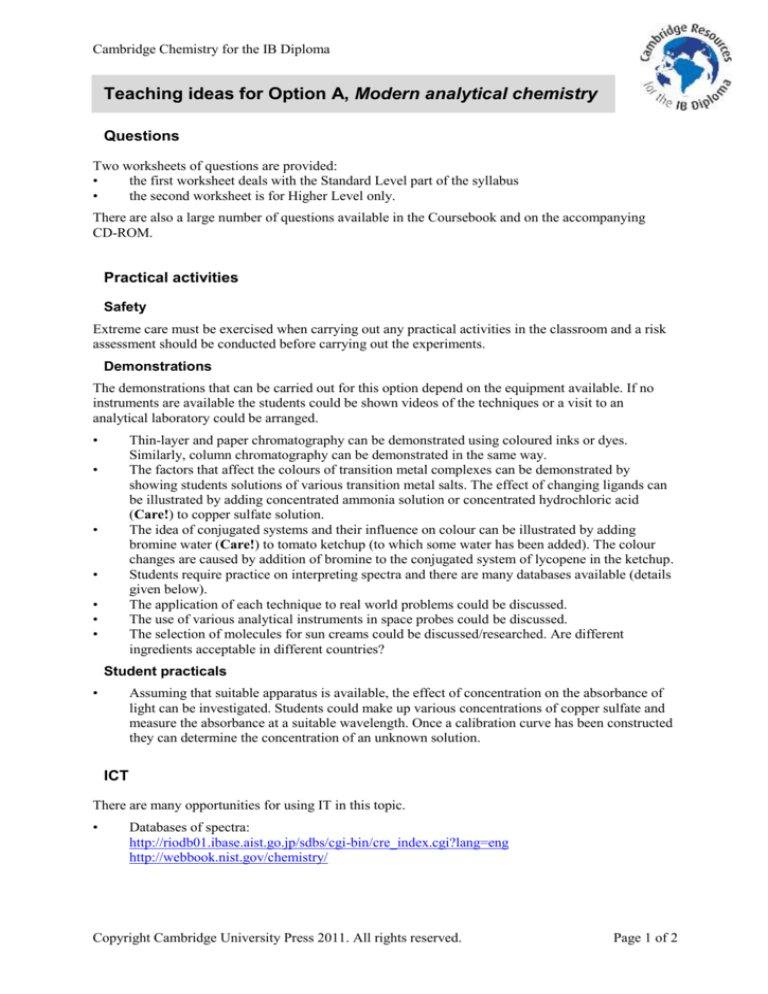
Cambridge Chemistry for the IB Diploma
Teaching ideas for Option A, Modern analytical chemistry
Questions
Two worksheets of questions are provided:
•
the first worksheet deals with the Standard Level part of the syllabus
•
the second worksheet is for Higher Level only.
There are also a large number of questions available in the Coursebook and on the accompanying
CD-ROM.
Practical activities
Safety
Extreme care must be exercised when carrying out any practical activities in the classroom and a risk
assessment should be conducted before carrying out the experiments.
Demonstrations
The demonstrations that can be carried out for this option depend on the equipment available. If no
instruments are available the students could be shown videos of the techniques or a visit to an
analytical laboratory could be arranged.
•
Thin-layer and paper chromatography can be demonstrated using coloured inks or dyes.
Similarly, column chromatography can be demonstrated in the same way.
The factors that affect the colours of transition metal complexes can be demonstrated by
showing students solutions of various transition metal salts. The effect of changing ligands can
be illustrated by adding concentrated ammonia solution or concentrated hydrochloric acid
(Care!) to copper sulfate solution.
The idea of conjugated systems and their influence on colour can be illustrated by adding
bromine water (Care!) to tomato ketchup (to which some water has been added). The colour
changes are caused by addition of bromine to the conjugated system of lycopene in the ketchup.
Students require practice on interpreting spectra and there are many databases available (details
given below).
The application of each technique to real world problems could be discussed.
The use of various analytical instruments in space probes could be discussed.
The selection of molecules for sun creams could be discussed/researched. Are different
ingredients acceptable in different countries?
•
•
•
•
•
•
Student practicals
•
Assuming that suitable apparatus is available, the effect of concentration on the absorbance of
light can be investigated. Students could make up various concentrations of copper sulfate and
measure the absorbance at a suitable wavelength. Once a calibration curve has been constructed
they can determine the concentration of an unknown solution.
ICT
There are many opportunities for using IT in this topic.
•
Databases of spectra:
http://riodb01.ibase.aist.go.jp/sdbs/cgi-bin/cre_index.cgi?lang=eng
http://webbook.nist.gov/chemistry/
Copyright Cambridge University Press 2011. All rights reserved.
Page 1 of 2
Cambridge Chemistry for the IB Diploma
•
•
•
•
•
•
•
•
•
•
•
•
Databases:
http://www.rsc.org/Education/Teachers/Resources/Databook/index_databases.htm
http://www.science-and-fun.de/tools/
http://www.lohninger.com/spectroscopy/dball.html
Spectra, tutorials and videos of techniques:
https://www.le.ac.uk/spectraschool/
Videos of modern chemical techniques can be found in the RSC section of YouTube:
http://www.youtube.com/profile?user=wwwRSCorg#g/u
Description of some techniques:
http://chem-ilp.net/labTechniques/LabTechniques.htm
Mass spectrometry simulation:
http://www.oraxcel.com/projects/masssim/index.htm
More in-depth description of NMR spectroscopy:
http://www2.chemistry.msu.edu/faculty/reusch/VirtTxtJml/Spectrpy/nmr/nmr1.htm
NMR questions:
http://www.chem.ucla.edu/~webspectra/
http://heat.usc.edu/chem322a/interactive/c4h10o.html
Spectroscopy problems:
http://orgchem.colorado.edu/hndbksupport/spectprob/problems.html
http://www.chem.ucalgary.ca/courses/351/spectroscopy/index.html
http://www.nd.edu/~smithgrp/structure/workbook.html
AAS and chromatography:
http://www.shsu.edu/~chm_tgc/sounds/sound.html
Colours of transition metal complexes:
http://michele.usc.edu/105b/105bfall98/resources/resource.html
Animations on spectroscopy and chromatography:
http://www.shsu.edu/~chm_tgc/sounds/sound.html
Azo dye synthesis:
http://www.chem.cuhk.edu.hk/English/RBS6E_Student/Student_Expt_8_eng.pdf
http://www.users.muohio.edu/taylorrt/combichem/Lab%20Experiment%20in%20Azo%20Dye
%20Preparation.htm
Theory of knowledge (TOK)
The use of reasoning to determine the structures of molecules could be discussed.
Copyright Cambridge University Press 2011. All rights reserved.
Page 2 of 2


